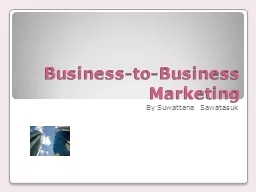/


By Suwattana Sawatasuk What is BusinesstoBusiness B2B marketing It refers to the process of buying amp selling goodsservices to be used in the production of other goodsservices ID: 781611
Download The PPT/PDF document "Business-to-Business Marketing" is the property of its rightful owner. Permission is granted to download and print the materials on this web site for personal, non-commercial use only, and to display it on your personal computer provided you do not modify the materials and that you retain all copyright notices contained in the materials. By downloading content from our website, you accept the terms of this agreement.
Slide1
Business-to-Business Marketing
By Suwattana Sawatasuk
Slide2What is Business-to-Business (B2B) marketing?
It refers to the process of buying & selling goods/services to be used in the production of other goods/services,
for consumption by the buying organization, and/or
for resale by wholesalers and retailers
Slide3B2B and B2C
B2BBusiness-to-Business
B2C
Business-to-Consumer
Ultimate user:
Business
Ultimate user:
individual household consumer
Slide4Type of Business Products
Major equipment: capital goods such as large or expensive machines, airplanes, and buildings
Accessory equipment:
goods, such as portable tools and office equipment, that are less expensive and shorter-lived than major equipment
Raw materials:
unprocessed extractive or agricultural products, such as mineral ore, timber, corn, fruits, vegetables, and fish
Component parts:
either finished items ready for assembly or products that need very little processing before becoming part of some other product i.e. diesel engines for trucks, tires and electric motors for automobiles
Processed materials:
product used directly in manufacturing other products i.e. sheet metal, chemicals, specialty steel, corn syrup, and plastics
Supplies: consumable items that do not become part of the final product i.e. lubricants, detergents, paper towels, pencils, and paper
Slide5Derived demand
The demand of B2B sales is often derived from the B2C sales in the same supply chain
Slide6B2B Organizations
Manufacturers or Producers
Resellers:
are marketing intermediaries that resell manufactured products without significantly altering their form
Institutions
Government
Slide7B2B Buying Process
Need Recognition
Product
Specification
RFP Process
Proposal Analysis & Supplier Selection
Order
Specification
Vendor/
Performance
Assessment
Slide8B2B Buying Process (
con’t)
Need Recognition
:
the buying organization recognizes, through, either internal & external sources, that it has an unfilled need
Product Specifications:
the organization considers alternative solutions and come up with potential specifications that suppliers might use to develop their proposals to supply the product
Slide9B2B Buying Process (
con’t)
RFP Process:
RFP (Request for Proposals) is a common process through which buying organizations invite alternative suppliers to bid on supplying their required components
Proposal Analysis, Vendor Negotiation, and Selection:
the buying organization evaluates all the proposals it receives in response to its RFP
Slide10B2B Buying Process (
con’t)
Order Specification:
the firm places its order with its preferred supplier(s). The order includes detailed prescription of the goods, prices, delivery dates, and penalties if the order is not filled on time (for some firms). Then, the supplier will send an acknowledgement that it has received the order and fill it by specified date.
Vendor Analysis:
firms analyze their vendor’s performance so they can make decisions about their next purchases. Analysis for B2B is typically more formal and objective than B2C.
Slide11Factors Affecting the Buying Process
The buying center: all the individuals and units that involved in the purchase decision
Role
The one who…
Sample of Computer Purchase
Initiator
First
suggests making a purchase
Division general manager
proposes to replace company’s computer
Influencers/ evaluators
Influence the buying decision and often help define specifications and provide info. for evaluating options
Corporate controller’s office and vice president of data processing
have an important say in which system & vendor the company will deal withGatekeepers
Regulate the flow of info.
Corporate department for purchasing & data processing analyze company’s needs and recommend likely matches with potential vendors
DeciderHas the formal/informal power to choose or approve the selection of supplier or brand
Vice president of administration, with advice from others, selects vendor the company will deal with and system it will buy
UsersActually use the product
All division employees use the computers
Slide12Factors Affecting the Buying Process
(con’t)
Organizational culture:
Buying situations
New buy:
a situation requiring the purchase of a product for the first time
Modified
rebuy
:
a situation where the purchaser wants some change in the original good or service i.e. new colorStraight rebuy
: a situation in which the purchaser reorders the same goods/services without looking for new info. or investigating other suppliers
Slide13Factors Affecting the Buying Process
(con’t)
Organizational culture
Autocratic buying center:
1 person make decision alone
Democratic buying center:
based on majority rule
Consultative buying center:
1 person make decision based on consultative idea
Consensus buying center: all members of the team must reach a collective agreement that they can support a particular purchase